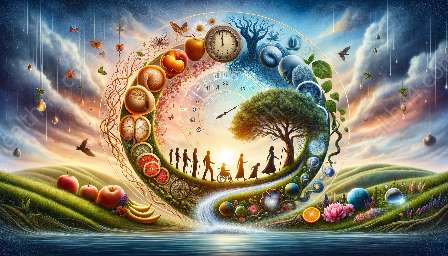Reproductive aging in men is a natural and inevitable process that affects their reproductive health. Understanding the impact of aging on male reproductive health provides valuable insights into the factors that influence fertility, sexual function, and overall well-being. This article delves into the complex interplay between reproductive aging in men and its connections to reproductive health, shedding light on the real effects and potential interventions.
Understanding Male Reproductive Aging
Male reproductive aging, also known as andropause or late-onset hypogonadism, refers to the gradual decline in reproductive hormones, particularly testosterone, and the physiological changes that occur as men age. Unlike women who experience a relatively rapid decline in fertility with menopause, men undergo a more gradual decline in reproductive function over a longer period of time.
One of the key markers of male reproductive aging is the decline in androgen production, leading to changes in sexual function, sperm production, and overall reproductive capacity. While the rate of decline varies among individuals, the effects of reproductive aging can significantly impact male fertility and reproductive health.
Impact on Reproductive Health
The impact of reproductive aging in men on reproductive health encompasses various aspects of male fertility and sexual function. As men age, they may experience a decline in sperm quality and quantity, contributing to reduced fertility potential. Additionally, changes in sexual desire, erectile function, and ejaculatory function can be influenced by reproductive aging, affecting overall reproductive health and well-being.
Furthermore, reproductive aging in men is associated with an increased risk of age-related conditions that can impact reproductive health, such as benign prostatic hyperplasia (BPH) and prostate cancer. The age-related decline in testosterone levels can also lead to symptoms such as decreased muscle mass, increased body fat, and reduced bone density, affecting overall physical health and vitality.
Exploring Factors and Real Effects
Several factors contribute to the effects of reproductive aging in men on their reproductive health. Chief among these factors is the decline in testosterone production, which plays a crucial role in regulating male reproductive function. Other factors, such as lifestyle choices, environmental influences, and underlying health conditions, can also interact with reproductive aging to impact male reproductive health.
The real effects of male reproductive aging go beyond fertility and sexual function. They encompass the broader influence on overall health and well-being, including cardiovascular health, metabolic function, and cognitive performance. Understanding these real effects is essential in addressing the multifaceted nature of reproductive aging and its implications for men's health.
Reproductive Aging in Men and Overall Reproductive Health
Reproductive aging in men is intricately connected to overall reproductive health, as it is a fundamental aspect of male reproductive function. By understanding the complex relationship between reproductive aging and overall reproductive health, individuals can take proactive steps to preserve and optimize their reproductive capacity as they age.
Addressing reproductive aging in men within the context of overall reproductive health involves a holistic approach that considers not only fertility and sexual function but also the broader physical, mental, and emotional aspects of reproductive well-being. By recognizing the interconnectedness of reproductive aging with overall health, individuals can make informed decisions to promote their reproductive and overall well-being.
Interventions and Future Considerations
As research continues to advance our understanding of reproductive aging in men and its impact on reproductive health, various interventions and strategies are being developed to address the challenges associated with aging and male reproduction. These interventions include hormone replacement therapy, lifestyle modifications, and reproductive technologies that aim to support male reproductive function and fertility as men age.
Future considerations in the field of reproductive aging involve ongoing research into the underlying mechanisms of age-related changes in male reproductive function, as well as the development of personalized approaches to managing reproductive health in aging men. By embracing a proactive approach to reproductive aging, individuals can navigate the aging process while maintaining their reproductive and overall health.


